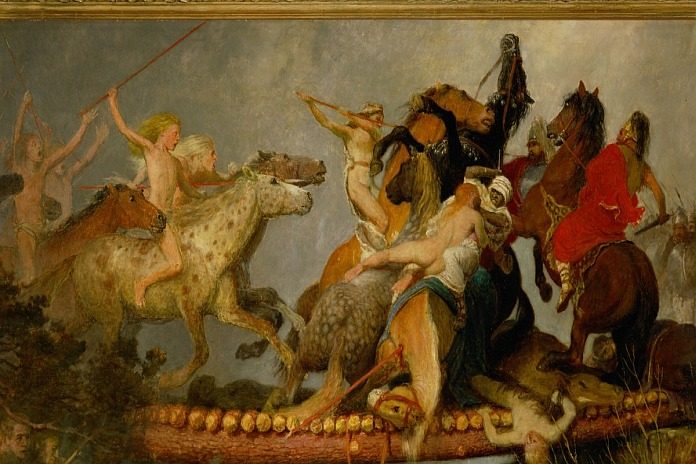Dear Sir:
One of the world’s nastiest collection of brutally barbaric peoples came to an end in 1922. The Ottoman Empire, empire created by Turkish tribes in Anatolia (Asia Minor) that grew to be one of the most powerful states in the world during the 15th and 16th centuries. The Ottoman period spanned more than 600 years and came to an end only in 1922 when it was replaced by the Turkish Republic and various successor states in southeastern Europe and the Middle East.
The word Ottoman is a historical Anglicization of the name of Osman I, the founder of the Empire, and the ruling House of Osman, also known as the Ottoman dynasty. Osman’s name, in turn, was the Turkish form of the Arabic name ʿUthmān (عثمان ).
The Ottoman Empire during World War 1 was a German Allie and supporter. They had declared war on both Britain and Russia. The World War 1 Allies Armistice of October 31, 1918, ended the fighting between the defeated Ottoman Empire and the Allies but did not bring stability or peace to the region. The British were in control of Syria, Palestine, and Mesopotamia (Iraq), and British, French, and Greek forces stood ready to march across the Bulgarian border and occupy Ottoman Thrace and Constantinople.
End of the massacring butchers of the Ottoman Empire. Between the fighting on multiple fronts, the deaths from massacre and starvation, and the almost complete dislocation of economic life across swaths of Anatolia and the Arab provinces, the war that ended Ottoman rule also destroyed many of the institutions that had sustained it.
The End of the Ottoman Empire. All of the region’s modern nations were born from the collapse of the empire, orchestrated by the superpowers of the day, France, and Great Britain. Today’s political, religious, and ethnic challenges in Bosnia, Kosovo, Turkey, Lebanon, Syria, Israel, Palestine, and Iraq are born out of this.
To understand the hatred of the Turks for the Kurds, one must see that it is an ingrained hatred. Turkey, the Ottoman Empire, began killing Armenians, many of whom were Kurds, as long ago as the 1400s. Over the centuries the Ottomans/Turks slaughtered millions of them, so much so as can now be defined as a tradition of hatred and murder, a tradition of genocide, ethnic cleansing, massacre, and extermination.
The Ottoman Empire stood as a defeated entity, one of the good things that came out of the victory over the German evil empire builder.
Until 1908, the Ottoman had been responsible for up to 90% of slavery in Europe and the Middle East for 600 years, raping and plundering mainly Middle European and East European countries. Capturing and selling the white slaves to those in the Middle East and Africa who wanted predominantly white slaves. Many millions of sad people succumbed to the evil of Ottoman slavery. Some may consider those very acts as a form of massacre considering the death numbers averaging 50 percent, death by castration, infections, and bleeding to death.
The male slaves were not just castrated; their penis was cut away as well. The Turkish predecessors, the Ottoman were evil butchers, today’s Turks are little better; after all, they are the same people, the same breed. They are gunning down civilians in Syria.
I am going back to the end of World 1 and the defeat and surrender of the Ottoman Empire. With regards to the Treaty of Sevres, a Peace Treaty concluded on August 10, 1920, after World War I at Sevres, France, between the Ottoman Empire (Turkey), on the one hand, and the Allies on the other. The treaty, which liquidated the Ottoman Empire and virtually abolished Turkish sovereignty, followed in the main the decisions reached San Remo. America wisely considered the Kurdish question. US President Woodrow Wilson and the Allied Nations supported the idea of an independent state for Kurds within the new Turkish State, after the fall of the Ottoman Empire.

The Kurds were granted a small self-ruled homeland by the Treaty of Sevres, which divided up the Ottoman Empire, signed on August 10, 1920. However, when the later replacement, the treaty of Lausanne, which redrew the borders of Turkey, was signed in 1923, this small homeland ceased to exist. The Kurds had been robbed of their homeland and thus began the long history of today’s bad Turkish-Kurdish relations. From day one of the treaty, the Turks began a plan to rid the nation of the Kurds.
The Turks were forced in Asia to renounce sovereignty over Mesopotamia (Iraq) and Palestine (including Trans – Jordan), which became British mandates; Syria (including Lebanon), which became a French mandate; and the kingdom of Hejaz. Turkey retained Anatolia but was to grant autonomy to Kurdistan. Armenia became a separate republic under international guarantees, and Smyrna (modern Izmir) and its environs were placed under Greek administration, pending a plebiscite to determine its permanent status.
In Europe, Turkey ceded parts of Eastern Thrace and certain Aegean islands to Greece, and the Dodecanese and Rhodes to Italy, retaining only Constantinople (modern Istanbul) and its environs, including the Zone of the Straits (Dardanelles and Bosphorus), which was neutralized and internationalized. The Allies further obtained virtual control over the Turkish economy with capitulation rights.
The Treaty of Sevres was accepted by the Turkish government of Sultan Mehmed Vahdettin VI at Istanbul but was rejected by the rival nationalist government of Kemal Atatürk at Ankara. Atatürk’s had a separate treaty with the USSR, and his subsequent victories against the Greeks during the War of Independence forced the Allies to negotiate a new treaty in 1923 (Treaty of Lausanne).
The Treaty of Lausanne was a peace treaty negotiated during the Lausanne Conference of 1922–23 and signed in the Palais de Rumine, Lausanne, Switzerland, on July 24, 1923. It officially settled the conflict that had originally existed between the Ottoman Empire and the Allied French Republic, British Empire, Kingdom of Italy, Empire of Japan, Kingdom of Greece, and the Kingdom of Romania since the onset of World War I. The original text of the treaty is in French. It was the result of a second attempt at peace after the failed Treaty of Sèvres, which was signed by all previous parties, except the Kingdom of Greece, but later rejected by the Turkish national movement who fought against the previous terms and significant loss of territory.
The National Movement opposed defining a Kurdish homeland. The Treaty of Lausanne ended the conflict and defined the borders of the modern Turkish Republic. In the treaty, Turkey gave up all claims to the remainder of the Ottoman Empire, and in return, the Allies recognized Turkish sovereignty within its new borders.
Among the reasons, because the new treaty excluded the Kurdish State, in the United States, the treaty was opposed by several groups, including the Committee Opposed to the Lausanne Treaty (COLT), and on January 18, 1927, the United States Senate refused to ratify the treaty by a vote of 50-34, six votes short of the two-thirds required by the Constitution.
The Treaty of Lausanne on the part of the Turks promised to respect and protect all existing religions, and minorities in the new state boundaries of Turkey. Those minorities included a fairly large Armenian population and the Turkish Kurdish Nation; the religions included Judaism and Christianity.
In 1937–38, the Turks killed [massacred] approximately 10,000-15,000 Alevis and Kurds Ref: Bruinessen, Martin van (1994). “Genocide in Kurdistan? The Suppression of the Dersim Rebellion in Turkey (1937-38) and the Chemical War Against the Iraqi Kurds (1988)” (PDF). In Andreopoulos, George J (ed.). Genocide: Conceptual and Historical Dimensions. Philadelphia: University of Pennsylvania Press. pp. 141–170.
Ref: David McDowall, A modern history of the Kurds, I.B.Tauris, Mayıs 2004, s.209 – Ref: “Alevi-CHP rift continues to grow after Öymen remarks.”
Today’s Zaman, November 24, 2009, and thousands went into exile. A key component of the Turkification process was the policy of massive population resettlement. Referring to the main policy document in this context, the 1934 law on resettlement, a policy targeting the region of Dersim as one of its first test cases, with disastrous consequences for the local population. Ref: Andreopoulos, George J. Genocide. p. 11
During the 1970s, the separatist movement coalesced into the Kurdish–Turkish conflict. From 1984 to 1999, the Turkish military was embroiled in a conflict with the PKK. The village guard system was set up and armed by the Turkish state around 1984 to combat the PKK. The militia comprises local Kurds, and it has around 58,000 members. Some of the village guards are fiercely loyal to the Turkish state, leading to infighting among Kurdish militants.
The countryside in the southeast was depopulated, with Kurdish civilians moving to local defensible centers such as Diyarbakır, Van, and Şırnak, as well as to the cities of western Turkey and even to Western Europe. The causes of the depopulation included the Turkish state’s military operations against the Kurdish population. An estimated 3,000 Kurdish villages in Turkey were virtually wiped from the map by the Turkish government, representing the displacement of more than 378,000 people.
“Evacuations were unlawful and violent. Turkish Security forces would surround a village using helicopters, armored vehicles, troops, and village guards, and burn stored produce, agricultural equipment, crops, orchards, forests, and livestock. They set fire to houses, often giving the inhabitants no opportunity to retrieve their possessions.
During such operations, security forces frequently abused and humiliated villagers, stole their property and cash, and ill-treated or tortured them before herding them onto the roads and away from their former homes. The operations were marked by scores of “disappearances” and extrajudicial executions. By the mid-1990s, more than 3,000 villages had been wiped from the map, and, according to official figures, 378,335 Kurdish villagers had been displaced and left homeless.”
In June 2010, several locations in Iraqi Kurdistan were attacked by the Turkish Air Force. The air attack was reported four days later in a news article released immediately after the attack. The tense condition had continued on the border since 2007, with both sides responding to each other’s every offensive move.
Following Turkey’s electoral board decision to bar prominent Kurdish candidates who had allegedly outstanding warrants or were part of ongoing investigations for PKK-links from standing in upcoming elections, violent Kurdish protests erupted on April 19, 2011, resulting in at least one casualty.
Jolly Green





